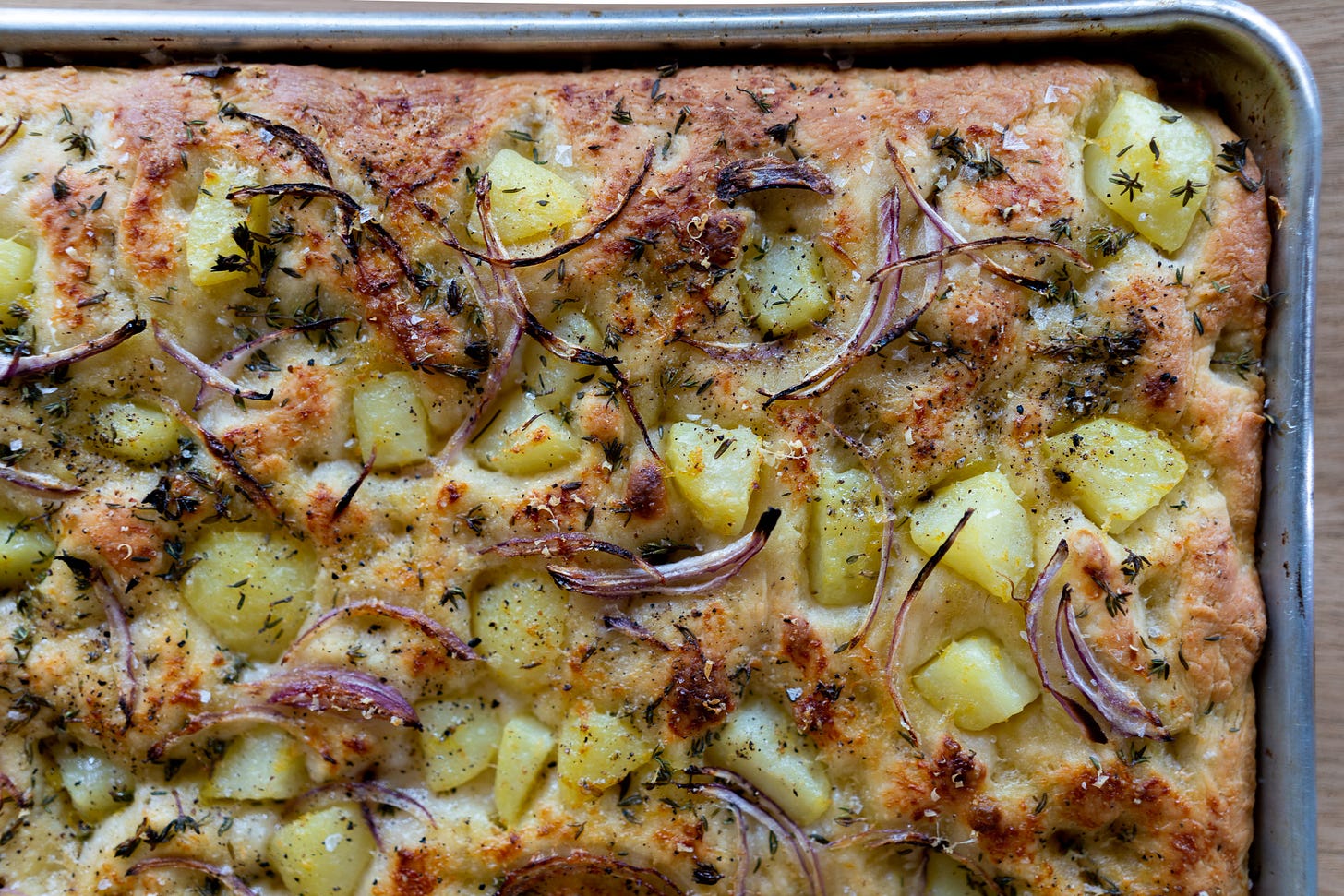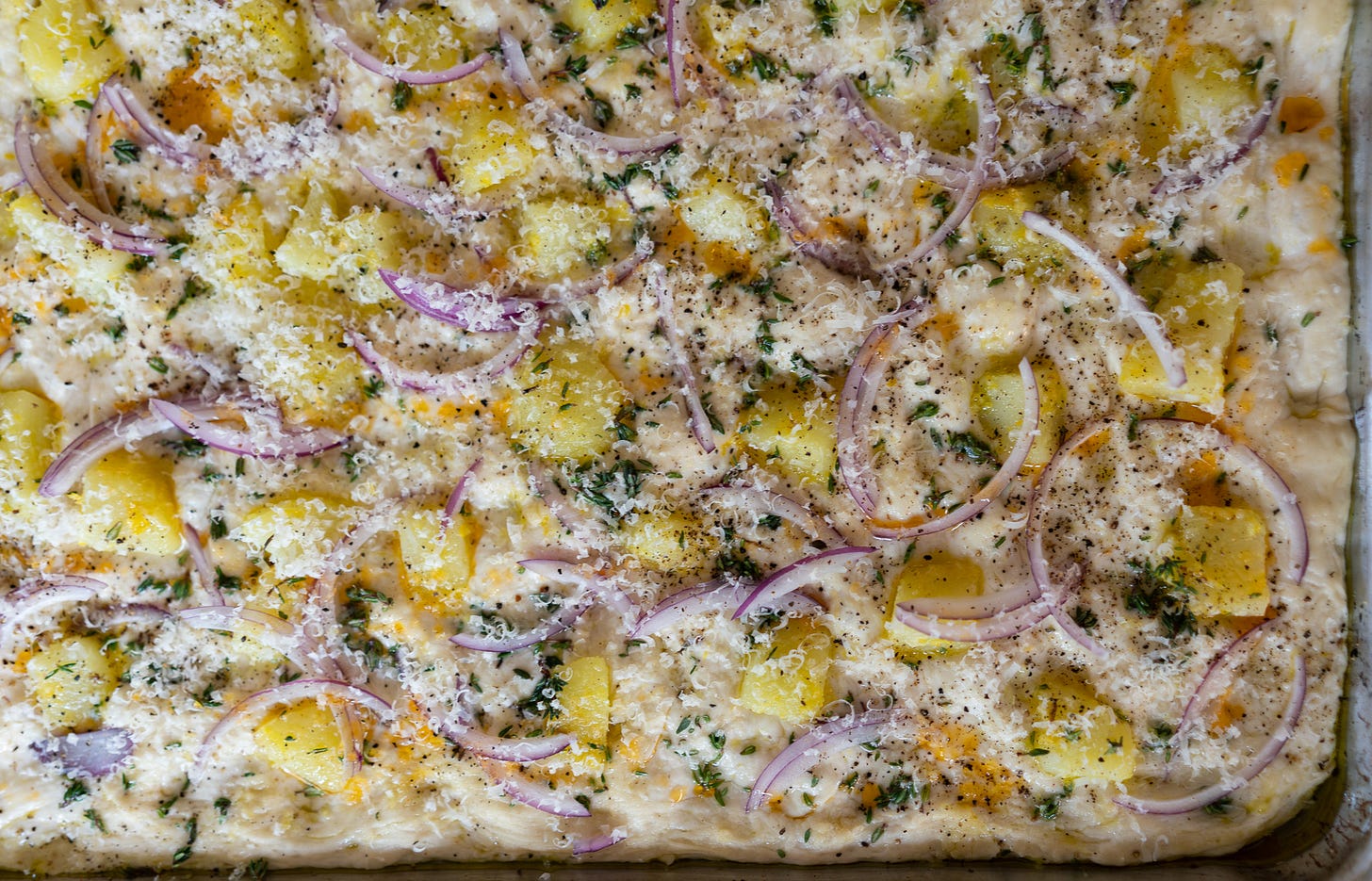A few weeks ago, I was walking around the farmer’s market in Portland and stumbled across some really delicious seasonal focaccia made by Tabor Bread. It had potatoes, cheese, thyme, and black pepper. I decided to try and recreate my own version of it in fear of them never making it again after the season was over.
I started with a really solid base - Samin Nosrat’s Ligurian focaccia recipe from Salt, Fat, Acid, Heat. Not only was the focaccia soft and airy - it was easy to make. Definitely something to make when you want to impress but don’t want to spend a ton of time preparing. Also a great intro recipe into bread making.
Yukon Gold, Red Onion, and Pecorino Focaccia Recipe
Adapted from Samin Nosrat’s Ligurian Focaccia recipe
For the dough:
2½ cups (600 grams) lukewarm water
½ teaspoon active dry yeast
2½ teaspoons (15 grams) honey
5 1/3 cups (800 grams) all-purpose flour
2 tablespoons (18 grams) Diamond Crystal Kosher salt or 1 tablespoon fine sea salt
¼ cup (50 grams) extra-virgin olive oil, plus more for pan and finishing
Flaky salt for finishing
For the topping:
3 small Yukon gold potatoes
1/4 of a red onion, sliced into thin strips
Zest of 1 lemon
2 tablespoons fresh thyme
Pecorino cheese (measure with your heart)
Black pepper
Calabrian chili oil (optional)
Flaky salt (I like Morton’s)
For the brine:
1½ teaspoons (5 grams) Diamond Crystal Kosher Salt
⅓ cup (80 grams) lukewarm water
The night before:
In a medium bowl, stir together water, yeast, and honey to dissolve. In a very large bowl, whisk flour and salt together to combine and then add yeast mixture and olive oil. Stir with a rubber spatula until just incorporated, then scrape the sides of the bowl clean and cover with plastic wrap. Leave out at room temperature to ferment for 12 to 14 hours until at least doubled in volume.
Next day:
The next morning, the dough should have doubled in size. Spread 2 to 3 tablespoons oil evenly onto a 18-by-13 inch (46-by-33 cm) rimmed baking sheet. When dough is ready, use a spatula or your hand to VERY gently release it from the sides of the bowl and fold it onto itself gently, then pour out onto pan. You’ll want to maintain as many air bubbles as you can. Pour an additional 2 tablespoons of olive oil over dough and gently spread across.
Gently stretch the dough to the edge of the sheet by placing your hands underneath and pulling outward. The dough will shrink a bit, and that’s ok. Let the dough rest if it keeps shrinking and come back to it 30 minutes later. Repeat stretching once or twice over the course of 1 hour to ensure dough remains stretched.
Dimple the dough by pressing the pads of your first three fingers in at an angle. Be careful not to be too heavy handed - I find that when I press too hard, the focaccia is more likely to stick to the bottom of the pan. At this point, I like to prepare and add the topping.
Preparing the topping:
Peel and dice three small Yukon gold or yellow potatoes. Boil until you can just pierce a fork through. Careful not to let them cook too long - they will continue to cook in the oven with the focaccia.
Once done, add potatoes to a bowl with a drizzle of olive oil and the zest of one lemon. I like to coat the potatoes with the lemon zest instead of sprinkling the zest over the focaccia, but you can do that too. Distribute the potatoes over the top of the focaccia, lightly pressing them into the dough.
Sprinkle top of focaccia with thyme, red onions, black pepper, flaky salt, and grated pecorino. Drizzle with Calabrian chili oil if you’d like.
Adding the brine:
Make the brine by stirring together salt and water until salt is dissolved. Pour the brine over the dough to fill dimples. Proof focaccia for 45 minutes until the dough is light and bubbly.
Thirty minutes into this final proof, adjust rack to center position and preheat oven to 450°F (235°C). If you have a baking stone, place it on rack. Otherwise, invert another sturdy baking sheet and place on rack. Allow to preheat with the oven until very hot, before proceeding with baking.
Sprinkle focaccia with flaky salt. Bake for 25 to 30 minutes directly on top of stone or inverted pan until bottom crust is crisp and golden brown when checked with a metal spatula. To finish browning top crust, place focaccia on upper rack and bake for 5 to 7 minutes more.
Remove from oven and brush or douse with 2 to 3 tablespoons oil over the whole surface (don’t worry if the olive pools in pockets, it will absorb as it sits). Let cool for 5 minutes, then release focaccia from pan with metal spatula and transfer to a cooling rack to cool completely.
Serve warm or at room temperature.
To store, wrap in parchment and then keep in an airtight bag or container to preserve texture. Gently toast or reheat any leftover focaccia before serving. Alternatively, wrap tightly to freeze, then defrost and reheat before serving.




